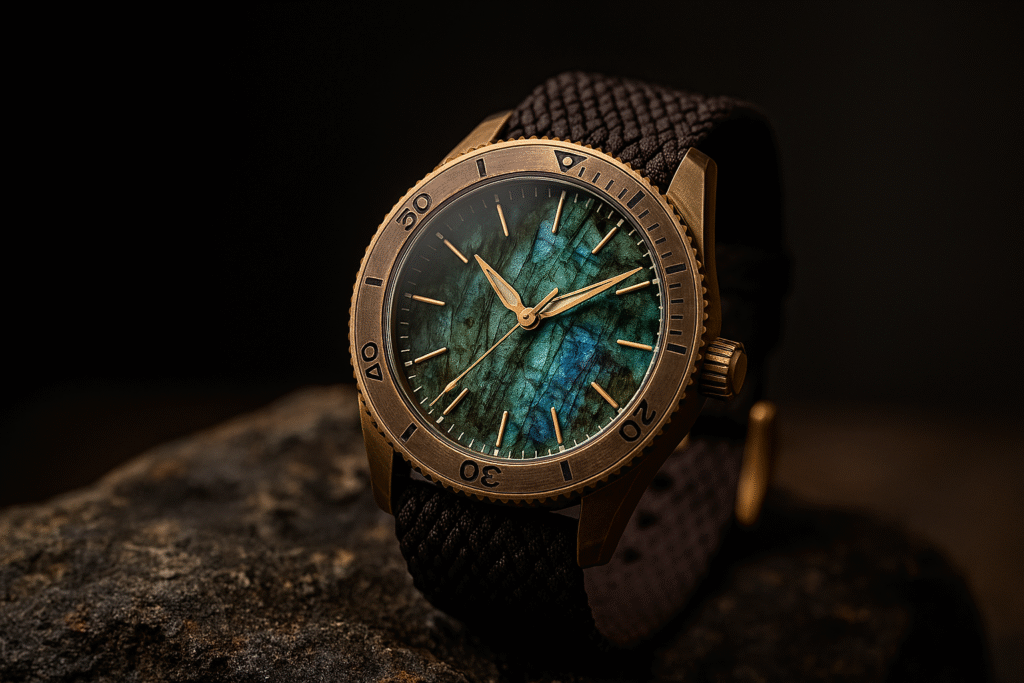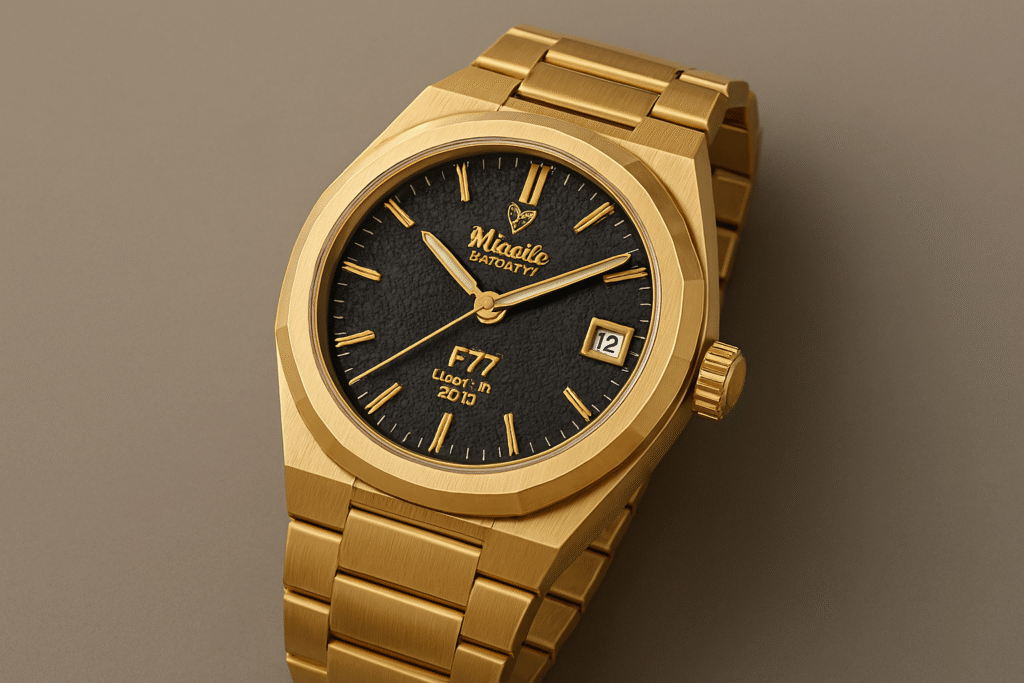Introduction
The Signum Cero Bronze Labradorite Watch is a unique collector’s timepiece. It combines a natural Labradorite dial, CuSn8 bronze case, Japanese automatic movement, and evolving patina. Each watch is one-of-a-kind, offering a dynamic piece that changes over time. Explore related watches in the gemstone watch guide.
Labradorite Dial in the Signum Cero Watch
The dial is crafted from Labradorite, a feldspar mineral first discovered in Labrador, Canada.
- Base colors: deep blue or purple
- Flashes of gold, yellow, or violet appear at certain angles
- Each dial is completely unique
Collectors who enjoy stone dials may also find the stone dial collector’s guide useful. The Labradorite’s natural optical effect ensures no two watches look alike.
Bronze Case and Patina Development
The CuSn8 bronze case comes in 39.5mm and 42.5mm. Bronze reacts naturally with air and moisture, forming a patina that gives each watch a personal character. Learn more in my bronze watch care guide.
Patina development depends on wear and climate, giving every timepiece a unique story. Collectors often prefer leaving the patina untouched for its aesthetic value.
NH35 and NH38 Japanese Movements
The Cero offers:
- NH35 automatic with lumed date disc
- NH38 automatic without date
These movements are widely trusted in microbrand watches (Seiko Instruments). For more details, see the NH35 vs NH38 guide or the automatic watch movement overview.
Why Collectors Choose the Signum Cero Bronze Labradorite Watch
- Unique stone dial patterns
- Patina evolves differently for every wearer
- Light reveals dynamic flashes of color
This combination of natural stone, bronze aging, and reliable movement makes the Signum Cero Bronze Labradorite Watch highly valued among collectors.
FAQ
Q: Will my dial match the photos?
A: Each dial is unique; flashes appear only at certain angles.
Q: How fast does patina form?
A: Usually within weeks, depending on humidity and air exposure.
Q: Can I polish the bronze case?
A: Yes, though most collectors prefer the natural patina.
Q: Why is the NH35 movement popular?
A: Known for precision and durability (Seiko Instruments).
Q: What case sizes are available?
A: 39.5mm or 42.5mm, with optional date or no-date.
Introduction
This comprehensive Watch Buying Guide answers the most common questions about timepieces.
Whether you’re purchasing your first watch or adding to your collection, these expert insights help you make informed decisions.
From understanding movement types to choosing the right size for your wrist, you’ll find everything needed before making a purchase.
What Types of Watches Should You Consider? – Watch Buying Guide Insights
Understanding the five main categories helps narrow your options:
- Mechanical watches – Use springs and gears. No battery needed.
- Quartz watches – Battery-powered; most accurate.
- Automatic watches – Wind themselves from wrist movement.
- Digital watches – Display time numerically on a screen.
- Smartwatches – Connect to your phone and track fitness data.
Accuracy Expectations – Watch Buying Guide Tips
- Quartz watches – Lose about 15 seconds per month.
- Mechanical watches – Lose 20–40 seconds per day.
- Atomic watches – Lose 1 second every 100 million years.
- Your phone’s clock stays perfectly accurate.
Water Resistance Considerations
Water resistance ratings affect usage scenarios:
- 30m – Handles rain and handwashing
- 50m – Safe for swimming
- 100m – Suitable for snorkeling
- 200m+ – Scuba diving
Replace gaskets every 2–3 years to maintain resistance.
Maintenance Schedule – Watch Buying Guide Advice
- Quartz watches – Battery replacement every 1–3 years.
- Mechanical watches – Full service every 3–5 years.
- Service costs: $200–800 depending on the brand.
Watch for stopping, running fast/slow, or condensation under the crystal.
Pricing Strategy
- Budget watches – Plastic cases, basic movements
- Mid-range watches – Steel cases, reliable mechanisms
- Luxury watches – Precious metals, hand-finished details
Remember: craftsmanship, materials, and brand prestige drive prices.
Sizing Advice
- 6–7 inch wrists – 38–42mm
- 7–8 inch wrists – 40–44mm
- 8+ inch wrists – 42–46mm
Ensure lugs don’t overhang wrist edges.
Complications to Prioritize
- Date display – Useful daily
- GMT hand – Second time zone
- Chronograph – Stopwatch
- Moon phase – Decorative
- Annual calendar – Adjusts month lengths
More complications = more things that can break.
Maintenance Tips
- Clean with a soft cloth
- Avoid extreme temperatures & magnets
- Wind manual watches daily
- Use watch winders for automatics
- Don’t adjust date between 9 PM–3 AM
Investment Potential
- Most watches lose value after purchase
- Only select Rolex, Patek Philippe, Audemars Piguet models appreciate
- Vintage watches from 1960s–70s show strong growth
- Buy watches you enjoy wearing, not solely for investment
Essential Tools
- Spring bar tool
- Case back opener
- Soft polishing cloth
- Watch cushion
- Demagnetizer
Where to Purchase
- Online – Better selection, often cheaper
- Physical stores – Try before buying
- Authorized dealers – Full warranties
- Grey market – Discounts, limited warranty
- Forums/eBay – Vintage pieces, verify authenticity
Learn More:


